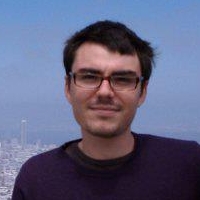WebGL Camp
I generally don’t do write-ups of events I go to (now that I actually check my blog I’ve never made one) but I had such a great time at WebGL Camp today and learnt so many new things that I think that (especially for the sake of my bad long term memory) I’ll do a write-up about my experience at WebGL Camp #4 at Mozilla HQs.
This is not going to be a chronological review but more like stuff I learnt about state-of-the-art WebGL, and the incredible community that we have here in the Bay Area around this technology.
On the things I learnt there’s that WebGLCamp this year gathered people that make great products and apps using WebGL; it also gathers people who like to write great WebGL frameworks either for games, art or data visualization and it also gathers people who define and participate directly on the making of the actual WebGL API. All of these people are together in the same place, discussing about these three things, and since this is a small group of very knowledgeable people, the outcome of this event is extremely valuable for the people there.
Just take a look at the agenda. In one day you will see how a profitable business like My Robot Nation uses WebGL as a core component of their product, you will also find out the technical aspects of implementing MapsGL in one of the most visited applications on the Web; you will also hear about how WebGL is an integral part for modeling and simulation in medical training applications and finally how the Department of Defense uses WebGL in their real time graphic simulation applications. Oh and yes, Autodesk also showcased their new WebGL applications.
So much changed since last year at WebGL Camp. While WebGL was still “alpha” and people built ideas on top of the thought that in the future it’ll become a solid and robust foundation, WebGL is now massively used in products/businesses that span to any possible field you could imagine!
Another very interesting aspect on this is that not only cool ideas around businesses show up, there’s a lot of discussion on technical stuff, on three different levels I would say: the standards body, the framework API designer/developer group and finally the consumers of these frameworks/APIs that create compelling demos, products and apps.
Just to name a few frameworks, Paul Lewis presented about A3 and Bartek Drozdz presented about J3D. Oh, and the Department of Defense said they were using GLGE for their applications. There was also a very interesting presentation of an Audio/Kinect/WebGL mashup that used CubicVR.js.
GLSLUnit was also presented by Google devs and a very interesting idea of using it to feature detect that a visitor to your site has an adecuate graphics card to run your WebGL application was suggested.
Another very interesting idea from the J3D framework was to design a special templating language that would render to proper glsl code to reuse shaders properly. Although J3D’s glsl language is pretty simple (only has a few special annotations), I would love to see something more like the Django templates in which inheritance, filters and include statements could be added in an easy way to reuse shaders.
Also, I really enjoyed Brandon Jones talk on texture (up and down)loading performance.
But what about me? I presented about PhiloGL last year at Google HQ’s for WebGLCamp #3, so this time it was all about meeting the people and not having any pressure on presenting anything :)
I also met today a couple of developers for OLPC that have been using and contributing code back to V8-GL for OpenGL/WebGL integration in the OLPC project. Can you believe it? V8-GL helps OLPC devs!

Finally there’s also the people who will talk to you about the future of the APIs you’re using. People working on the standard, who will actually listen to your experiences using the WebGL API and probably at the next iteration of WebGL Camp they will present some standard improvement that will include at least part of your ideas in it. And I’m not lying about this. You can witness that in the WebGLCamp #3 video (right towards the end) I was complaining about the fact that simple JSON was not enough as an interprocess/worker format, that it would be nice to be able to move typed arrays from one place to the other. This change was being added as I spoke and this year happened the exact same thing again. I talked two minutes to Ken Russell from Google about the structured cloning algorithm used for worker communication and how typed arrays still had to be cloned from here to there and he told me that transferable objects were just added to Chrome. Yay!
I really enjoyed this event and hope to see the community again for the next WebGL Camp. I had a great time and I think that there aren’t so many ocasions in which you can gather a group of people like this that have so many different backgrounds and ideas on such different topics related to WebGL like standards, products and frameworks.
A big props to Mozilla and Henrik Bennetsen from Katalabs for organising the event! Until the next WebGL Camp!






